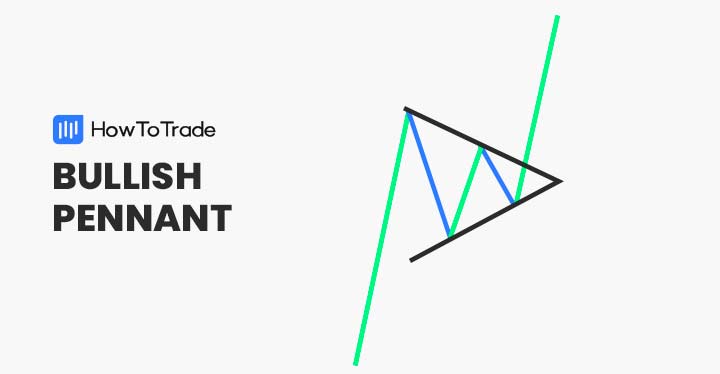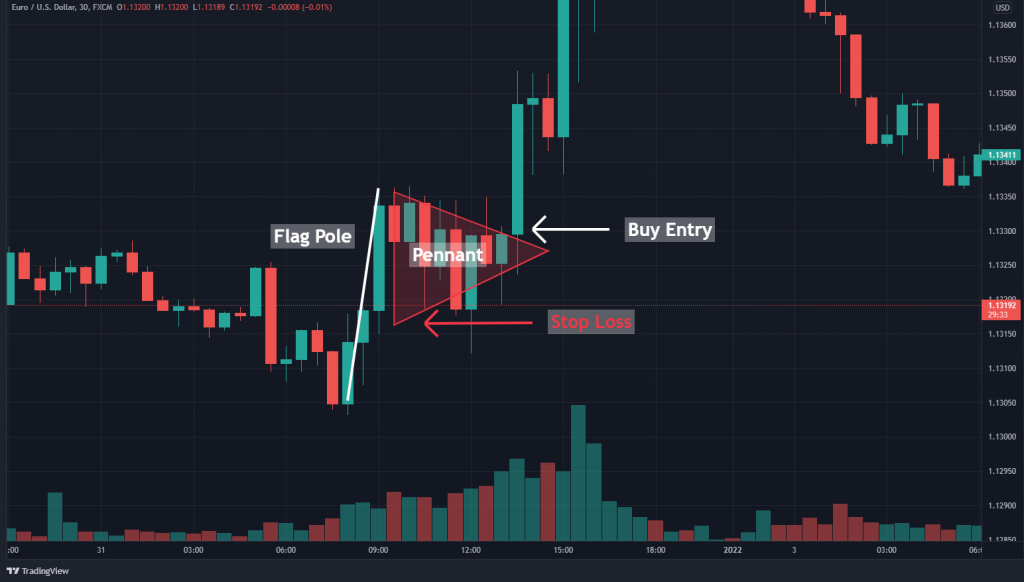
Are you searching for a reliable way to trade bullish trends? One such pattern is the bull pennant pattern.
The bullish pennant is a formation that signals the extension of an upward move in price. Read on to learn more about the bullish pennant pattern and how to trade this powerful technical tool.
 Table of Contents
Table of Contents
What is the Bull Pennant?
The bull pennant pattern is a technical analysis indicator that signals the extension of an uptrend. It consists of a single or series of upward price breaks, followed by market consolidation. The bullish pennant is among the strongest continuation patterns, as it frequently precedes up trend extension.
Visually, the pattern is similar to the bull flag as it consists of an uptrend (flag pole) and a period of the sideways price action (pennant). However, the bull pennant features converging trendlines that form a triangle instead of a flag. It is commonly viewed as a buy signal and a way of entering prevailing bullish trends.
How to Identify and Use the Bull Pennant?
Bull pennants are continuation patterns that suggest uptrend extension. As you can see in the EUR/USD chart below, they occur amid north-bound price action.

One of the best things about the bull pennant is that it is easy to identify and trade. Follow the steps below to utilize this technical indicator:
- Find a strong uptrend in price.
- Draw a bullish trend line. This is the flag pole.
- Identify a period of sideways price action.
- Draw an upward and downward trend line. The result should resemble a symmetrical triangle that is the pennant.
- To enter the market, place a buy order above the pennant.
- Place a stop-loss beneath the pennant to manage risk exposure.
- Use margin with care. Remember, margin carries significant risk.
Bull Pennant vs. Bear Pennant Pattern
Although both are continuation chart patterns, there are some critical differences between bullish and bearish pennants. Below are the primary discrepancies:
- A bearish pennant occurs during a downtrend in price.
- Bullish and bearish pennants signal opposing order flow. Bullish suggests bids, while bearish suggests asks.
- Bearish and bullish pennants are used in opposing trading strategies. Bearish is used to sell the market, while bullish is used to buy the market.
When trading, it’s important to remember these facets of bearish and bullish pennants.
How to Trade Bull Pennant Chart Patterns?
Perhaps the best thing about trading chart patterns is that they are intuitive. The bull pennant is no exception. All you have to do is identify an uptrend, build the pennant, set your profit target, and stop loss. That’s it!
Step 1: Identify the Trend
The first step in trading the bull pennant pattern is identifying an uptrend. We are looking for a single or series of upward price breaks to do so. If price action is disjointed, it’s essential that a price bar or series of price bars are moving in the same direction with an upward trajectory.
Once an uptrend is spotted, a trend line is drawn. The bullish trend line is the flag pole for our pennant.
Step 2: Build the Bullish Pennant
The pennant portion of the bullish pennant chart pattern is a primary element in this formation. It is a period of price consolidation that tightens from right to left. Visually, it resembles a symmetrical triangle.
To build the pennant, execute the following steps:
- Draw a downward-sloping upper trend line that connects the tops of the consolidating price bars.
- Draw an upward-sloping lower trend line that connects the bottoms of the consolidating price bars.
- The converging trend lines should resemble a symmetrical triangle.
Step 3: Set Profit Targets and Stop Losses
Trading technical analysis indicators such as the bullish pennant are pretty straightforward. All you need to do is set your market entry, profit target and stop loss. The following progression illustrates how easy trading bull pennants can be:
- Draw the pattern
- Place a buy order above the upper trend line
- Place a stop-loss order below the lower trend line
- Place a profit target at the desired level above entry

The Bull Pennant – Pros and Cons
As with all tools and indicators, bull pennants have a unique list of pros and cons. Let’s take a look at a few of the most important.
Pros
- Visually striking, easy to identify
- Found frequently in all financial markets, on all time frames
- User friendly and strategically intuitive to trade
Cons
- Can produce false signals and “fake-outs.”
- Pennants on large time frames require extensive capital to trade
- Trend reversals and retracements can pose trade management challenges
Everything About the Bullish Pennant Pattern in One Video
Check our video by our trading analysts on how to identify and trade the bullish pennant pattern.
Key Takeaways
In a nutshell, here’s what you need to remember about the bull pennant chart pattern:
 Key Points to Take Away
Key Points to Take Away
- The bull pennant is a continuation pattern that signals the possible extension of an uptrend.
- The bullish pennant is the opposite of the bearish pennant. It suggests that a buying opportunity may be in the offing, not selling.
- Visually, the pattern consists of two parts: a flag pole and a pennant. The flag pole represents the bullish trend; the pennant indicates consolidation.
- Trading the bull pennant is easy. Place a buy order above the upper bounds of the pennant, with a stop-loss order beneath the lower bounds.
Frequently Asked Questions (FAQs)
Here are some of the most frequently asked questions about the bullish pennant pattern in the financial markets:
What happens after the bullish pennant pattern?
When the bullish pennant pattern is formed, a strong upward movement is likely to occur when the price breaks above the pennant.
Are bearish pennants and bullish pennants reliable tools for technical analysis?
Yes. But, it’s important to remember that no indicator is 100% accurate. When trading pennants, be sure to use proper risk management.
What’s the difference between the bullish pennant pattern and the bull flag pattern?
Both the bullish pennant and the bull flag are technical analysis patterns that are typically seen in bullish markets. A bull flag pattern is formed when there is a strong upward move in price (the “flagpole”) followed by a period of consolidation (the “flag”) where the price trades within a narrow range, typically forming a downward sloping channel. Once the consolidation phase is over, the price typically breaks out of the channel and continues the upward trend.
A bullish pennant, on the other hand, is also formed after a strong upward move in price, but instead of a flag, the consolidation phase is marked by a symmetrical triangle pattern. The triangle is formed by two converging trend lines, with the price moving back and forth within the triangle. Once the triangle pattern is complete, the price typically breaks out of the triangle and continues the upward trend.
In terms of differences, the key distinction between the two patterns is the shape of the consolidation phase. A bull flag has a downward sloping channel, while a bullish pennant has a symmetrical triangle pattern. Additionally, the duration of the consolidation phase in a bull flag tends to be shorter compared to a bullish pennant.
Risk Disclosure: The information provided in this article is not intended to give financial advice, recommend investments, guarantee profits, or shield you from losses. Our content is only for informational purposes and to help you understand the risks and complexity of these markets by providing objective analysis. Before trading, carefully consider your experience, financial goals, and risk tolerance. Trading involves significant potential for financial loss and isn't suitable for everyone.



